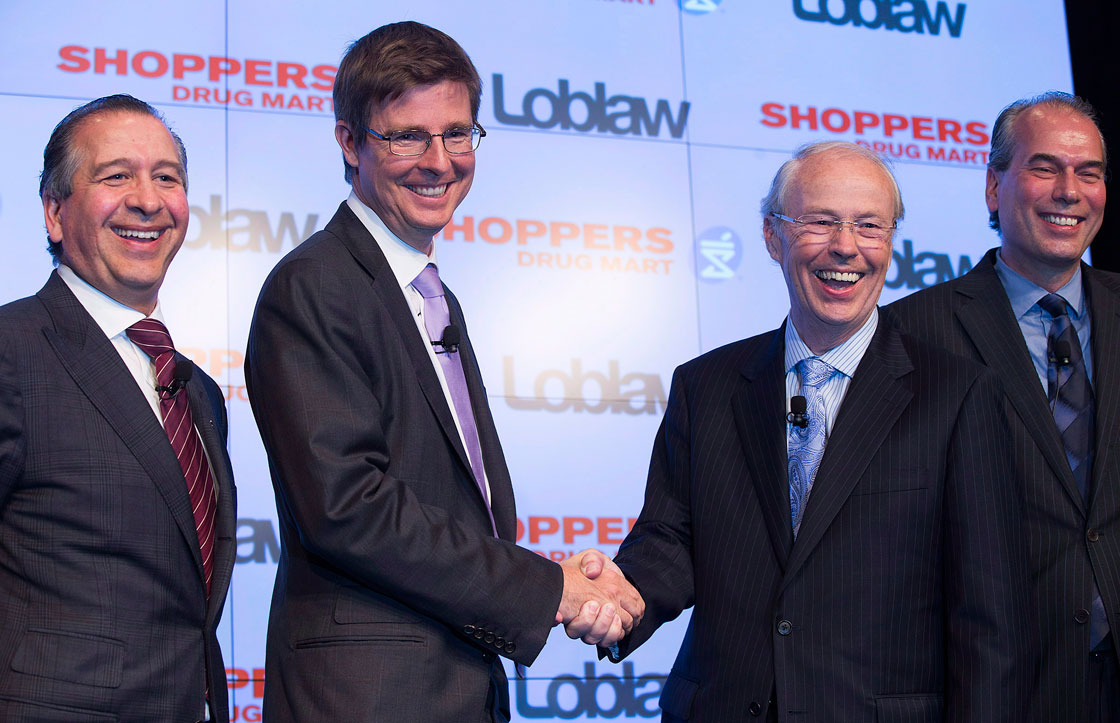A pair of mega-mergers between the country’s biggest grocery store operators and pharmacy this past summer is raising concern among consumer advocacy groups and academics over the potential for the blockbuster deals to result in higher prices at the checkout.

The Consumers Association of Canada and others are calling for federal regulators to request sales and pricing data from Loblaw Cos. Ltd., Shoppers Drug Mart Corp., Canada Safeway and Sobeys to determine if the proposed mergers will harm consumers.
“We view this as a loss of competition,” Bruce Cran, president of the consumer group, said of the deals.
Sobeys parent Empire Co. Ltd. bid $5.8 billion in mid-June for Safeway Canada Ltd. That deal, combined with encroachments by U.S. giants Walmart and Target onto grocers’ home turf, triggered Loblaw’s $12.4-billion offer for Shoppers Drug Mart in July.
Both transactions are under review by the Competition Bureau, a spokesperson said, which is preparing to meet with consumer groups, wholesalers who supply the grocery chains and other industry stakeholders this month to discuss the impact of the Loblaw bid.
The CAC plans to release a report on the mergers later this month after the association meets with regulators, Cran said.
Read more: How the Shoppers-Loblaw deal could affect consumers
In a paper published on the Loblaw-Shoppers transaction last month and sent to the mergers branch of the bureau, Douglas West, an economist and chair of the Department of Economics at the University of Alberta, has called for officials to conduct an extensive analysis of prices on overlapping product lines.
He’s concerned that overlapping products – such as packaged food goods and personal care products sold at Shoppers and banners owned by Loblaw – could be subject to price increases following the deal.
“That is one of the concerns,” he said in an interview.
There’s also concern about substantially eliminating competition in smaller towns where Loblaw, Shoppers, and or Safeway and Sobeys represent the biggest competitors in the area.
Consolidation of Loblaw and Shoppers will combine 2,293 stores under one company with sales topping a mammoth $42-billion annually. That compares to a combined Sobeys-Safeway boasting 1,513 stores under different banners with pro-forma revenue of $24 billion.
While experts and analysts have suggested the new post-merger environment could cut consumers better deals – fueled by competitive pressure from the likes of Wal-Mart as well as the greater scale and leverage the merged companies will hold over suppliers— others suggest it’s just as likely the opposite could occur.
That’s why federal regulators must conduct a thorough analysis of the mergers, West said, adding, “the ability exists to do that.”
“They would have to request the price and sales data from the parties, and they would have to take a look at the overlapping product lines that are sold by the companies in their supermarkets and drugstores and then determine through an econometric analysis what the possible effect would be by eliminating one of the firms,” West said.
In an emailed statement, Competition Bureau spokesperson Greg Scott said the bureau “cannot speak about ongoing merger reviews for reasons of confidentiality.”
But Scott added, “In reviewing mergers, the bureau considers many different elements, including the level of economic concentration in the relevant industry and the merging parties’ market shares.”
Stock analysts have speculated that Sobeys owner Empire Co. Ltd. could be forced to divest between 20 and 45 Safeway locations in Western Canada to clear competition concerns. Divestitures could be in the cards for Shoppers as well, some experts suggest.
“You could have a situation in a neighborhood shopping centre where you’ve got a Shoppers and Loblaw right next to one another, and now they’re going to be owned by the same company,” West said.
Executives for Loblaw and Empire have said publicly the deals will provide each with the necessary scale to remain competitive in a food retail environment where prices and profit margins are under pressure.
“From a consumer point of view, we don’t care about that,” the CAC’s Cran said. “Canadians generally don’t have a great deal of sympathy for these arguments. I live in a little suburb of Vancouver, and we’ve got a Safeway and a Sobeys.”


Comments